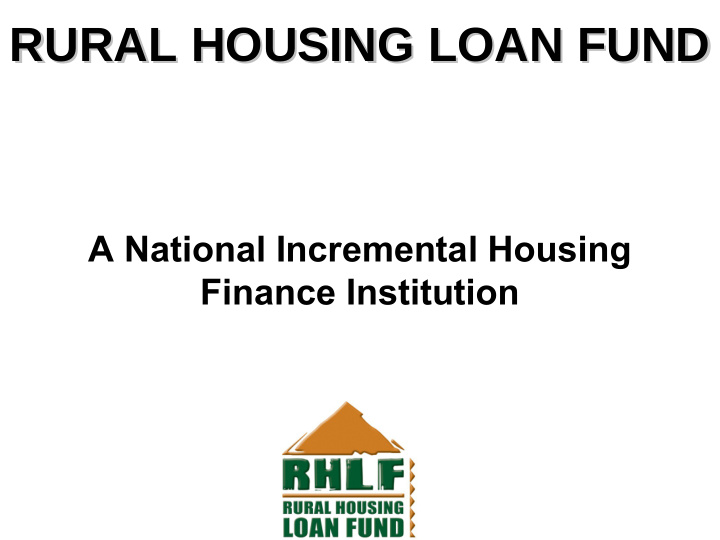



RURAL HOUSING LOAN FUND RURAL HOUSING LOAN FUND A National Incremental Housing Finance Institution
Contents • HMF in SA • RHLF establishment & Mandate • RHLF Business Model • RHLF Development Impact (2011/12) • Concluding Remarks
DEVELOPMENT OF HOUSING MICROFINANCE IN SA HMF as a sub-sector of microfinance has grown in line with the growth of the microfinance industry in South Africa SA’s democracy Access to housing microfinance started in earnest in 1996 after Strauss Commission recognized the need to enable access to finance to poor areas of South Africa—rural areas In 1996, nobody knew at the time if the market even existed Since 1996 a lot has happened as will be shown in the following slides through the Rural Housing Loan Fund experience
RHLF’s Establishment & Funding Result of German-South African bi-lateral agreement Established by SA govt. in September 1996 as a Section 21 company as a wholesale financial institution (wholly owned by SA government) Report to NDHS and the National Parliament (via Portfolio Committee on Human Settlements) Focus on facilitating access to housing finance by low income earners Funding: Initially capitalised with DM50 million (R150 million) grant from German Development Bank, KfW, to the SA government Raised loan of €12.5 from KfW via DBSA—fully drawn Government: R49.5m (2010//11 & 2011/12) & R32m(2012/13)
RHLF’s Vision Statement RHLF is a world class rural social venture capital fund that creates new financial arrangements and opportunities for rural families to improve their housing, economic and living environments.
Core Principles Core Principles Wholesale Housing Finance to viable Retail Lenders / Intermediaries Targets working low income households / end-user borrowers earning ≤ (R9800p.m) currently Supports incremental housing construction, extensions & improvements Targets Rural Areas— defined in mandate as non- metropolitan
Types of Funding Types of Funding Instruments Instruments Core Product : Structured Loan Facility Investment Instruments : Pilot Loans Equity Subordinated debt
SOME STRATEGIC QUESTIONS THAT RHLF HAS HAD TO DEAL WITH the political and external market pressures to reach financial sustainability versus poverty alleviation/development impact as evidenced by the high Total Cost of Credit (TCOC) charged to end-users the financial difficulties at some retail partners that hold the potential to deplete the capital base of the fund the issue of a substantial proportion of RHLF-funded loans leaking into consumption and thus missing the housing finance and personal development mandate
RHLF RESPONSE TO STRATEGIC QUESTIONS: MORE HOUSING, AT A LOWER TOTAL COST OF CREDIT Entails Growth Strategy premised on new strategic business initiatives, grouped as follows: a) Operational Enhancement: • Community based loan origination—stokvels, cooperatives • Savings linked housing credit • Financing alternative building technologies
RHLF RESPONSE TO STRATEGIC QUESTIONS: MORE HOUSING, AT A LOWER TOTAL COST OF CREDIT…cont.
Savings linked housing credit Objective is to tap into groups of low- • income borrowers displaying superior financial discipline Targeted with lower cost, longer tenor • housing finance product Result in achieving housing aspirations • quicker and less expensive than conventional housing finance approach
Community based loan origination Idea is to leverage the social capital of rural • communities in the expectation of higher dev impact and better repayment behaviour Accept the small volumes that volunteer-based • community channels can handle Possibility of operational efficiency if multiple • community organizations feed their loan originations to a capacitated MFI: disbursements, loan admin & collections
Linking with building materials suppliers Low income rural households are facing steep • materials prices, mainly due to transport costs. RHLF has identified building material suppliers • operating in non-metros and has linked them with RHLF approved lenders.
INFORMAL SETTT UPGRADING 14
15
16
RHLF DEVELOPMENT IMPACT 2012/13 FY
Impact performance: Disbursements
Cumulative Number of Loans
Impact performance: Loan Usage
Impact performance: Income Levels
Impact performance: Employment
Impact performance: Gender Split
Impact performance: Provincial Distribution
Impact performance: Provincial Distribution
Impact performance: Presidential Rural Nodes This concerted effort will be undertaken within 3 (three) years from the 30 November, 2012
CONCLUDING REMARKS • Each of the strategic initiatives (models & operational enhancements) has potential for higher development impact; but equally there are inherent risks in each that need to be well managed in order to achieve broader goal of enhancing housing development for the low- income households in rural areas • Strong and working partnerships have to be in place for any low income housing finance to succeed • Housing Microfinance is proof that market based interventions/solutions can and do address the needs of the poor
Thank You Tsaliko Ntoampe B.A (Econ), Pdm, M(DevF)
Recommend
More recommend